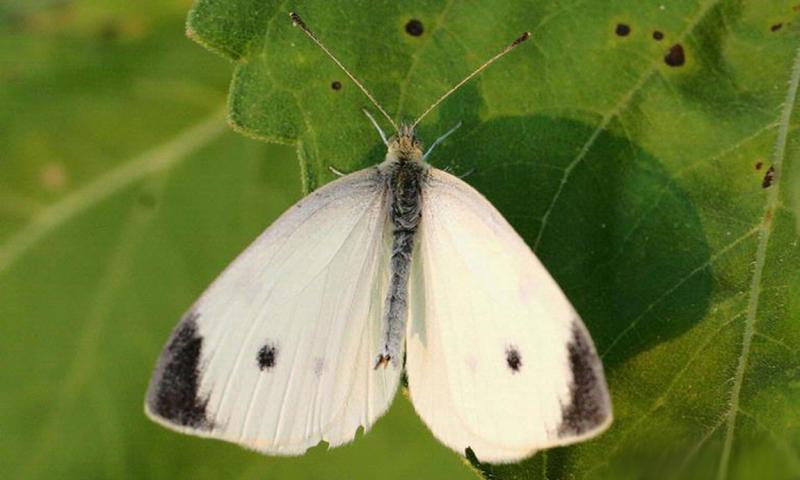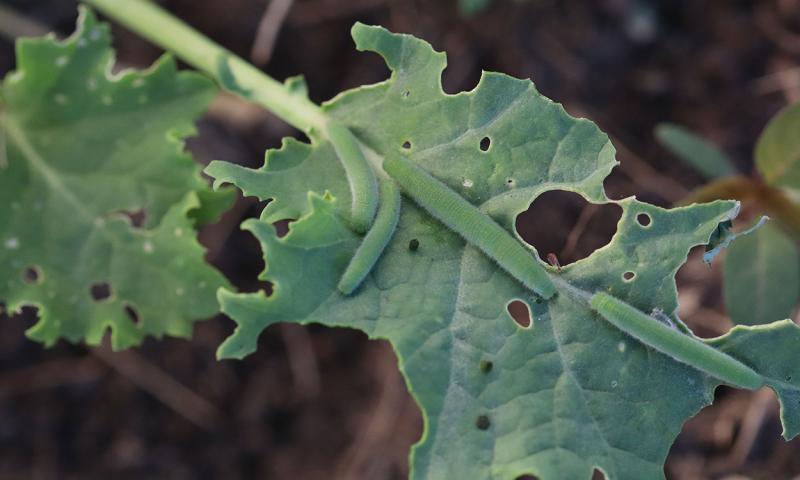Originally Submitted: September 7, 2023
While harvesting kale, cabbage, Brussels sprouts or any other cold crops, it is common to see a few holes in the leaves. However, within the last week, there has been a noticeable increase in small holes in the leaves, which seem to be getting larger in size. The culprit behind these holes is none other than the cabbage white caterpillars (also known as imported cabbageworms). The impending defoliation boom was declared a week before when a large population of cabbage white butterflies were floating around my garden. These caterpillars can be quite a nuisance and leave behind ragged-looking leaves, as well as a significant amount of frass (caterpillar droppings).
Cabbage White Identification and Lifecycle
Butterflies

The cabbage white butterflies are white and have a dark marking on the tip of the wings and two black spots on each wing. The wing markings are much easier to observe when the butterfly lands. Sometimes the inner spot is faded (Figure 1).
These butterflies are often observed fluttering around the garden, but pay close attention to the plants that they land on, as they are likely laying eggs on the underside of the leaves. Their presence is a good indicator that defoliation of certain garden produce is soon to occur.
Feeding Behavior
Within a week of seeing the butterflies, the caterpillars will be active on the plants that the eggs were laid on. Signs of their presence on garden crops include small, smooth holes, which are produced by the recently hatched caterpillars.

As they develop, the caterpillars may skeletonize entire leaves, leaving only the midrib veins.
Severe defoliation can occur rapidly once caterpillars are present, as it is common to observe more than one caterpillar on a single plant or even on a single leaf (Figure 2).
If left unmanaged, cabbage white caterpillars can defoliate the entire plant. In plants like cabbage, the caterpillars may also bore into the developing heads, which forces cabbage to be carefully evaluated before processing to avoid an unwanted caterpillar surprise.
Caterpillars
The cabbage white caterpillars are dark green with a solid yellow line that runs down the middle of their back. They have a broken yellow line, or hashmarks, on each side of their body (Figure 3).

The caterpillars have a fuzzy appearance when examined, due to the presence of numerous fine hairs that cover their bodies. When disturbed, the caterpillars curl up, but will typically remain on the leaf they are feeding on.
Management
Since the cabbage white caterpillars are not extremely mobile, it is possible to simply remove the caterpillars by hand and destroy them. If possible, harvesting the infested leaves and submerging them in a cold saltwater bath will also remove the caterpillars, as well as their droppings and any other unwanted critters (I personally use coarse salt and cold tap water; it’s important to place something on top of the kale in the sink to ensure that the kale is fully submerged).
There are insecticides labeled for gardens that can be used if there are a lot of caterpillars present on multiple plants. Remember, if you use an insecticide, always check the pre-harvest interval that is present on the label. The preharvest interval indicates the number of days after treatment that must elapse before harvest of the treated crop can occur. It is also important to read the label and determine what personal protective equipment is necessary for application. If applying an insecticide dust, we recommend wearing a dust mask or respirator to ensure that the insecticidal powder is not being inhaled. Chemical-resistant gloves should also be used to reduce exposure. Organic insecticides that are effective against imported cabbageworms include products containing Bt (Bacillus thuringiensis) or spinosad as the active ingredient.
Cabbage white caterpillars can often be managed by natural enemies (including wasps) or diseases that affect their populations. Since there are 2 to 4 generations per year of imported cabbageworms, it is important to continue scouting for these pests even after one generation of caterpillars is effectively removed from the garden. Monitor the plants for caterpillar activity and scout more intensively after cabbage white butterflies are observed in the garden.


